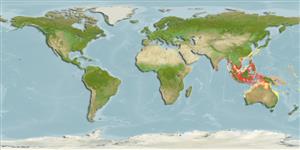Teleostei (teleosts) >
Pleuronectiformes (Flatfishes) >
Cynoglossidae (Tonguefishes) > Cynoglossinae
Etymology: Cynoglossus: Greek, kyon = dog + Greek, odous = teeth + Greek, glossa = tongue (Ref. 45335).
More on author: Bleeker.
Environment: milieu / climate zone / depth range / distribution range
Ecology
Marine; demersal. Subtropical
Western Pacific: China and Java, Indonesia (Ref. 40966).
Size / Weight / Age
Maturity: Lm ? range ? - ? cm
Max length : 39.1 cm TL male/unsexed; (Ref. 124479); max. published weight: 353.50 g (Ref. 124725)
Life cycle and mating behavior
Maturity | Reproduction | Spawning | Eggs | Fecundity | Larvae
Li, S. and H. Wang, 1995. Fauna Sinica, Osteichthyes. Pleuronectiformes. 433p. Fauna Sinica series. Beijing: Science Press. (Ref. 33837)
IUCN Red List Status (Ref. 130435: Version 2024-2)
Threat to humans
Harmless
Human uses
Tools
Special reports
Download XML
Internet sources
Estimates based on models
Preferred temperature (Ref.
123201): 25.3 - 29.1, mean 28.4 °C (based on 1030 cells).
Phylogenetic diversity index (Ref.
82804): PD
50 = 0.5000 [Uniqueness, from 0.5 = low to 2.0 = high].
Bayesian length-weight: a=0.00288 (0.00184 - 0.00453), b=3.17 (3.04 - 3.30), in cm total length, based on LWR estimates for this species & Genus-body shape (Ref.
93245).
Trophic level (Ref.
69278): 3.5 ±0.4 se; based on size and trophs of closest relatives
Resilience (Ref.
120179): Medium, minimum population doubling time 1.4 - 4.4 years (Preliminary K or Fecundity.).
Fishing Vulnerability (Ref.
59153): Low to moderate vulnerability (29 of 100).
